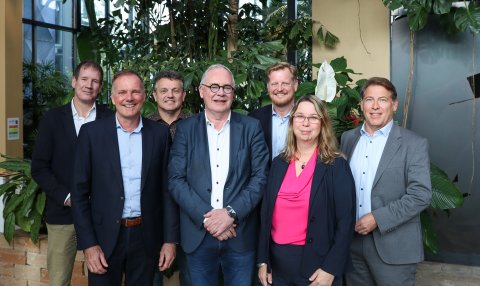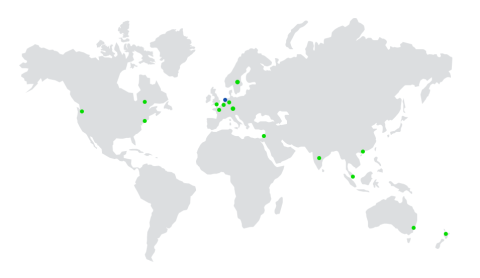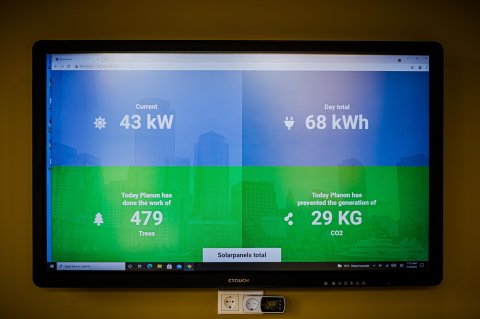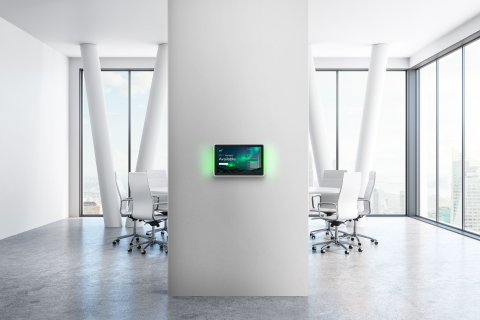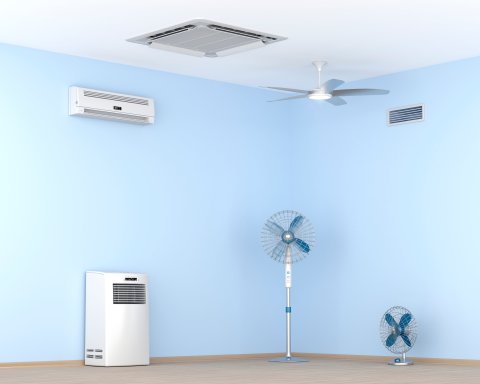
IoT sensors have become a game-changer in the real estate and facility management industry. With their ability to capture data from various assets and equipment and provide real-time insights, these sensors are revolutionizing the way buildings are managed. In this article, we will explore the benefits and use cases of IoT sensors in corporate real estate (CRE) and facility management (FM) and understand how they are transforming the industry.
Table of Contents
- What are IoT sensors?
- The role of IoT sensors in FM, Real Estate and Property Management
- Common Applications and Sensor Types in CRE and FM
- IoT sensor applications to support CRE and FM teams
- What are the top IoT sensors for CRE and FM?
- How to start using IoT sensors for real estate and facility management
What are IoT sensors?
IoT sensors, short for Internet of Things sensors, are devices designed to capture data from various assets and equipment, and make that data available in real time through the internet. These smart devices are incredibly versatile and can measure multiple signals such as temperature, pressure, light, movement, gas concentrations, and more.
Once the data is collected, it is transmitted over the internet to a central information system. In this system, the data undergoes normalization, processing, or enhancement. Once these steps are completed, the data is transformed into valuable information that can be used to track trends or gain insights. Users can access this data conveniently through a cloud platform, usually offered as a Software-as-a-Service offering, allowing convenient access from anywhere and at any time.
To enhance user convenience and reduce maintenance costs, IoT sensors employ different techniques.
Firstly, they utilize wireless technologies like cellular, Wi-Fi, Bluetooth, or LPWAN to connect to the cloud. This shift away from wired Ethernet connections has made it easier for numerous companies to embrace IoT technology.
Secondly, certain IoT sensors are battery-powered, allowing them to operate autonomously for up to 10 years without human intervention. This significantly reduces maintenance expenses.
The role of IoT sensors in FM, Real Estate and Property Management
IoT sensors gather vital data from buildings and their assets. This data can play a significant role in facility management (FM) and corporate and commercial real estate by providing valuable insights on occupancy, temperature, air quality, and energy consumption. It can address key questions, such as:
- How can I monitor energy and water usage for operational savings and ESG reporting?
- How can I reduce energy costs?
- How can I improve occupant comfort, workplace experience and employee well-being?
- How can I see which spaces are used the most, or under-utilized?
In this way, corporate real estate and facility managers can enhance building performance, lower energy consumption, boost occupant comfort, improve workplace experience, and enhance employee well-being.
IoT sensors establish a connection between the physical aspects of a building, including spaces and assets, and their digital counterparts known as digital twins. By harnessing data from these sensors at the business application level, service delivery can be enhanced in various areas such as predictive maintenance management, optimized space utilization, energy management, and condition-based cleaning.
Common Applications and Sensor Types in CRE and FM
Here is an overview of some the most common applications for IoT sensors in corporate real estate (CRE) and facility management (FM) and a description of the different types of sensors that can be used for each application.
IoT sensors to monitor energy consumption and increase efficiency
The CRE and FM industry is increasingly recognizing the need to combat climate change and implement sustainable practices such as energy conservation. In this context, the use of IoT has emerged as a game-changing technology for energy monitoring and efficiency.
IoT sensors can be embedded in devices and systems, providing valuable insights into energy usage, performance, and areas for improvement. Organizations can leverage IoT-enabled energy monitoring to make informed decisions and take targeted actions to optimize energy consumption. This will reduce their environmental footprint and energy costs.
By adopting IoT-enabled energy monitoring, companies can meet regulatory requirements and demonstrate their commitment to mitigating climate change.
IoT sensors for energy monitoring are commonly integrated into HVAC and lighting systems, electrical panels, meters and submeters. Current sensors monitor the current drawn by specific equipment or areas within a building, providing insights into energy consumption patterns. Voltage sensors monitor voltage fluctuations, identify irregularities, and optimize energy efficiency. Voltage sensors can also provide data on power quality, helping detect issues such as voltage sags or surges.
A recent study found that annual energy consumption from smart buildings was reduced by over 38% with smart HVAC and smart lights.
Other types of sensors can help with energy efficiency. For example, data from occupancy sensors can trigger energy-saving measures such as adjusting lighting or HVAC settings when a space is unoccupied. Pressure sensors can be integrated to monitor air pressure within different zones of a building. By continuously monitoring and analyzing the data, facility managers can optimize the HVAC system's performance, ensuring consistent air circulation, temperature control, and energy efficiency.
IoT sensor applications to enhance workplace experience
A smart, IoT-enabled workplace enhances the workplace experience. It makes employees more mobile, safer, and better informed. It also supports CRE and FM teams in automating business processes, driving efficient interactions with stakeholders, and improving business insight. There are several applications for IoT sensors that directly support an improved workplace experience for building users:
Smart room and desk booking for improved space utilization and occupant experience
IoT sensors, such as motion or occupancy sensors, can be installed in meeting rooms or office spaces to detect occupancy in real time. These sensors can identify whether a room or desk is currently in use or vacant. By integrating this data with a booking system, employees can easily identify and book available rooms and desks, reducing conflicts and optimizing utilization. A smart meeting room using iot directly benefits office users.
Occupancy sensors can detect whether a reserved room is unoccupied during a scheduled booking time. If the sensors detect no activity or occupancy within a certain timeframe, the system can automatically release the room. This helps mitigate instances of unused rooms, improving utilization efficiency and improving the employee experience.
Also, facility managers can utilize the data to optimize cleaning schedules. By focusing cleaning efforts on areas with high occupancy or foot traffic, resources can be allocated efficiently, ensuring cleanliness where it matters the most.
IoT sensors for improved comfort and safety
IoT sensors offer a range of benefits for improved comfort and safety in the workplace. Proximity sensors, when integrated into lighting systems, play a crucial role in creating a convenient and energy-efficient environment. By detecting the presence or absence of people in a room, these sensors can automate the lighting control process. For instance, in areas such as restrooms, proximity sensors can trigger the lights to switch on automatically as soon as someone enters. This eliminates the need for manual operation and ensures that individuals have immediate access to proper lighting, enhancing their comfort and convenience.
Furthermore, the use of gas sensors in the workplace can prevent dangerous circumstances from occurring. For instance, kitchens can be equipped with gas sensors to detect the presence of hazardous gases like carbon monoxide. These sensors continuously monitor the air quality and raise an alarm or trigger safety measures if dangerous gas levels are detected. By providing early detection and warning, gas sensors help protect the well-being of employees and prevent potential accidents or health hazards.
IoT sensors for Smart Parking
A vehicle detection sensor instantly detects the presence or absence of vehicles, offering real-time updates on parking space occupancy. Drivers can conveniently access this information via mobile apps or digital signage, allowing them to quickly locate available parking spaces. This efficient system minimizes the time spent searching for parking and helps reduce traffic congestion within the parking lot.
By integrating this data with a booking system, the sensors can verify the availability of a reserved space and guide the driver to their designated spot upon arrival.
The sensors also play a role in parking enforcement by monitoring parking session durations. They can detect instances of overstaying or unauthorized parking and generate notifications or alerts for parking attendants or enforcement personnel. Furthermore, IoT sensors enhance car park security by utilizing number plate recognition systems to identify suspicious or unauthorized vehicles.
Learn more about IoT in real estate and facility management

How to benefit from IoT in 2023: discover the potential for your organization
Read more
Planon Workplace Insights
Watch now
Unlock the benefits of Planon IoT
Read moreIoT sensor applications to support CRE and FM teams
There is a multitude of applications for IoT sensors that support CRE and FM teams:
Asset and equipment tracking for accurate inventory management
Strategically positioned IoT sensors, such as RFID readers, Bluetooth beacons, or GPS trackers, can enable real-time tracking of assets within a building. As assets equipped with tagged identifiers pass by these sensors, their locations are automatically recorded and transmitted to a central management system.
This enables accurate and efficient inventory management by providing a real-time inventory status and reducing the risk of loss or misplacement.
Condition monitoring for preventive maintenance
Temperature, humidity, vibration, pressure, current and voltage sensors can be attached to equipment and infrastructure throughout a building. These data points can be used as specific indicators of asset health and transmitted to a central system or cloud-based platform for storage, processing, and analysis.
Facility managers or maintenance personnel can access the real-time data and insights from a centralized dashboard or mobile application, allowing them to monitor asset health and performance regardless of their physical location.
Through the analysis of collected sensor data, anomaly detection algorithms can identify deviations from typical operating conditions. Unusual trends, patterns, or breaches of thresholds can activate alerts or notifications, notifying relevant personnel of potential issues or equipment failures. This proactive approach enables scheduled maintenance to address potential problems before they lead to costly downtime or breakdowns. This proactive approach enables scheduled maintenance to address potential problems before they lead to costly downtime or breakdowns.
IoT sensors can integrate with existing asset management systems, enabling seamless data exchange and incorporating condition monitoring data into asset maintenance records. Facility managers can make data-driven decisions, prioritize maintenance tasks, and allocate resources more effectively, ultimately leading to increased operational efficiency and cost savings.
Water quality assurance for health and safety compliance
pH sensors, conductivity sensors, turbidity sensors, and temperature sensors, deployed at key points in a building’s water supply system, can be used to continuously monitor the water quality.
The collected water quality data can be analyzed using algorithms and machine learning techniques. Deviations from normal levels or predefined thresholds can trigger alerts or notifications, enabling prompt response to potential water quality issues or Legionella contamination.
By utilizing IoT sensors for water quality monitoring, CRE and FM professionals can proactively identify and address potential water treatment quality issues, including the detection of Legionella bacteria. Real-time data collection, analysis, and remote monitoring capabilities enable prompt response, preventive maintenance, and efficient water management, ensuring the health and safety of occupants and compliance with regulatory standards.
Space planning for better real estate portfolio management
Occupancy sensors, people counters and people flow sensors can collect data over time to provide valuable insights into space utilization patterns. Analytics derived from occupancy data can help organizations identify underutilized or overbooked rooms, optimize space allocation, and make informed decisions on room sizes, amenities, and resource allocation.
For example, tracking the flow of people can enable CRE owners to analyze occupant behavior and space usage patterns, while acknowledging privacy limitations.
This information may help them identify excess capacity and develop action plans for peak hours, ultimately resulting in more efficient portfolio management.
Indoor Air Quality (IAQ) monitoring for wellbeing and productivity
The quality of the air we breathe indoors directly affects our health, comfort, and productivity. Poor IAQ can lead to a range of adverse effects, including respiratory issues, allergies, fatigue, and decreased cognitive function.
By utilizing sensors capable of measuring CO2 levels, humidity, particulate matter, and volatile organic compounds, facility managers can proactively monitor IAQ. This proactive approach enables the identification of potential issues at an early stage, allowing for timely interventions, adjustments, and improvements to maintain optimal air quality. Ensuring a healthier and more comfortable indoor environment promotes the well-being and productivity of building occupants.
What are the top IoT sensors for CRE and FM?
Here is a summary table, showing the commonly used sensor types for IoT applications in CRE and FM:
| Application | Common sensor types |
|---|---|
| Energy monitoring | Voltage, current, power, smart meters |
| Energy efficiency | Motion, occupancy, temperature, light |
| Smart room and desk booking | Occupancy (infrared/ultrasound) |
| Smart parking | Vehicle detection (magnetic/inductive) |
| Asset and equipment tracking | RFID, Bluetooth, GPS |
| Condition monitoring | Temperature, humidity, vibration, pressure, current, voltage |
| Water quality assurance | pH, conductivity, turbidity, temperature |
| Space planning | Occupancy (infrared/ultrasound), people count, people flow |
| Smart cleaning | Occupancy, people count, people flow |
| Indoor Air Quality (IAQ) monitoring | Temperature, humidity, C02, airborne particulates, volatile organic compounds |
Many of these applications can be deployed on the Planon platform using apps from our extensive network of tech partners.
How to start using IoT sensors for real estate and facility management
The integration of IoT sensors into corporate real estate (CRE) and facility management (FM) offers numerous benefits for enhancing workplace efficiency and productivity. Real-time data collected from these sensors provides valuable insights into building occupancy, temperature, indoor air quality, and energy consumption. This information empowers CRE and FM professionals to optimize building performance, improve energy efficiency, and create a comfortable environment for occupants.
By leveraging IoT-enabled energy monitoring, organizations can make data-driven decisions, implement targeted energy-saving measures, and demonstrate their commitment to sustainability. Additionally, IoT sensors enable various workplace applications, including smart room and desk booking, asset and equipment tracking, space planning, and smart cleaning. These applications streamline processes, enhance resource utilization, and improve the overall workplace experience.
Whether you’re just starting out, or thinking about extending your use of IoT sensors, you should be aware that there are some challenges and limitations:
- Scalability
Managing a large number of IoT sensors and the associated data can be challenging, requiring robust infrastructure and effective data management strategies. - Interoperability and standardization
Ensuring seamless communication and compatibility among different sensors, platforms, and devices from various vendors remains a challenge. - Data security and privacy
Protecting sensitive data from unauthorised access, ensuring secure communication, and addressing potential vulnerabilities in IoT systems is critical. - Power and battery management
IoT sensors often rely on battery power, which can pose limitations in terms of battery life, maintenance, and the need for periodic replacement or recharging. - Cost considerations
The initial investment and ongoing costs associated with implementing IoT sensors, infrastructure, and data management can be a limiting factor for some organisations.
The challenges and limitations as listed above indicate why it’s important to choose the right IoT platform for your real estate and facilities management processes. The Planon platform, with its built-in IoT capabilities helps you overcome the challenges while maximising the benefits in the shortest timescale.















